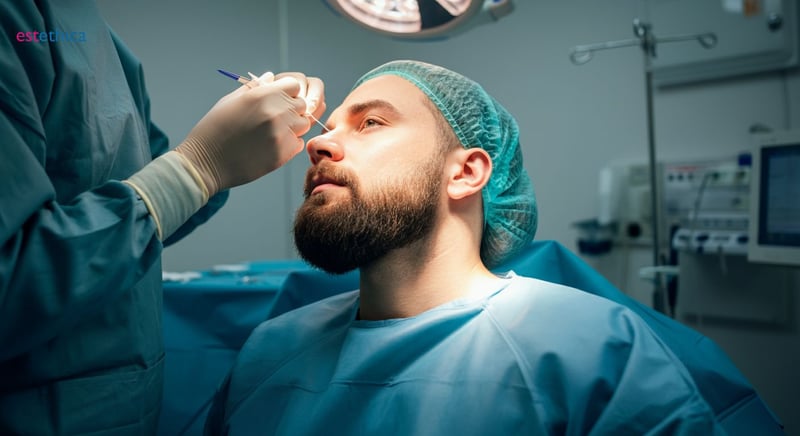Unlock Your Confidence: The Ultimate Guide to Beard Transplants
Explore the transformative power of beard transplants for a fuller, more confident you.
Are you considering a transformation that could enhance your facial features and boost your self-esteem? Beard transplants are increasingly becoming the go-to solution for men seeking a fuller, more defined beard. This guide will walk you through everything you need to know, from understanding the procedure to selecting the right clinic for your needs.
Understanding Beard Transplants: What You Need to Know
The Process of Beard Transplant Surgery
Beard transplant surgery involves a meticulous process where hair follicles are extracted from a donor area, usually the back of the scalp, and implanted into the beard region. This technique ensures that the transplanted hair matches the natural growth pattern and texture of facial hair.
- Consultation and Planning: A detailed consultation helps determine the desired beard shape and density.
- Follicle Extraction: Hair follicles are carefully harvested from the donor site using advanced techniques.
- Implantation: The follicles are strategically implanted into the beard area to achieve a natural look.
This procedure is typically performed under local anesthesia, allowing for a comfortable experience with minimal downtime.
Benefits of Beard Transplants
- Permanent Solution: Unlike temporary fixes, beard transplants offer a lasting solution for facial hair restoration.
- Natural Appearance: The transplanted hair grows naturally, blending seamlessly with existing facial hair.
- Boosted Confidence: Achieving the desired beard style can significantly enhance self-esteem and personal image.
Beard transplants are an ideal option for individuals struggling with patchy or uneven beard growth due to genetics or scarring. The results are not only aesthetically pleasing but also provide a permanent enhancement to one's appearance.

How Beard Transplant Surgery Works: A Step-by-Step Overview
Precision and Techniques in Beard Transplant Surgery
The beard transplant procedure is meticulously designed to ensure precision and natural results. Local anesthesia is administered to minimize discomfort during the process. This allows patients to remain comfortable while the surgeon focuses on the intricate task of hair follicle transplantation.
- Local Anesthesia: Ensures a pain-free experience during the procedure.
- Precision Implantation: Hair follicles are implanted with accuracy to mimic natural beard growth.
- Minimal Scarring: Modern techniques like FUE reduce visible scarring.
These advanced methods ensure that the transplanted hair integrates seamlessly with existing facial hair, providing a natural appearance.
Steps in the Beard Transplant Process
- Harvesting Follicles: Hair follicles are extracted from a donor area, typically the back of the scalp.
- Preparing the Recipient Site: The target area is prepared to receive the transplanted follicles.
- Implantation: Follicles are carefully implanted to achieve the desired beard density and shape.
Each step is crucial in ensuring the success of the beard transplant, with the ultimate goal of achieving a natural and aesthetically pleasing result.

Choosing the Right Clinic: Tips for Successful Facial Hair Restoration
Key Considerations for Selecting a Clinic
When considering a beard transplant, selecting the right clinic is paramount. A clinic's reputation can significantly impact the success of your facial hair restoration. Look for clinics with a proven track record in beard implant surgery, ensuring they use advanced techniques like Follicular Unit Extraction (FUE) or Direct Hair Implantation (DHI). These methods are known for their precision and minimal scarring.
- Clinic Reputation: Choose clinics with positive reviews and successful case studies.
- Advanced Techniques: Opt for clinics using FUE or DHI for optimal results.
- Qualified Surgeons: Ensure the clinic employs experienced and certified surgeons.
For instance, estethica is renowned for its innovative approaches and skilled professionals, making it a top choice for those seeking high-quality facial hair restoration.
Evaluating Clinic Credentials and Expertise
Before committing to a clinic, it's essential to evaluate their credentials and expertise. This involves researching the qualifications of the surgeons and the clinic's history in performing beard transplants. A clinic with a team of board-certified surgeons who specialize in facial hair surgery is ideal. Additionally, consider the clinic's commitment to ongoing education and adoption of the latest beard transplant techniques.
- Research Surgeon Qualifications: Verify board certifications and specialization in facial hair restoration.
- Review Clinic History: Look into the clinic's experience and success rates in beard transplants.
- Assess Technique Adoption: Ensure the clinic stays updated with the latest advancements in transplant methods.
By thoroughly evaluating these aspects, you can make an informed decision, increasing the likelihood of a successful and satisfying beard transplant experience.

Post-Procedure Care: Ensuring Long-Lasting Results
Essential Aftercare Practices for Optimal Beard Growth
Proper aftercare following a beard transplant is crucial for achieving the best results. Adhering to recommended guidelines can significantly enhance the healing process and promote healthy hair growth. For instance, avoiding direct sunlight and strenuous activities in the initial weeks can prevent irritation and ensure the transplanted follicles settle well.
- Gentle Cleansing: Use mild shampoos to clean the beard area without disturbing the follicles.
- Moisturization: Apply prescribed ointments to keep the skin hydrated and support healing.
- Avoid Touching: Refrain from scratching or rubbing the transplanted area to prevent dislodging follicles.
These practices not only aid in recovery but also contribute to the longevity and natural appearance of the beard transplant.
Long-Term Care for Sustained Beard Health
Maintaining the results of a beard transplant requires ongoing care and attention. Incorporating a balanced diet rich in vitamins and minerals can support hair health and growth. Additionally, regular grooming and trimming help maintain the desired beard shape and prevent split ends.
- Balanced Nutrition: Consume foods high in biotin and omega-3 fatty acids for hair strength.
- Regular Trimming: Keep the beard neat and prevent uneven growth.
- Hydration: Drink plenty of water to keep hair follicles nourished.
By following these long-term care strategies, individuals can enjoy a fuller, healthier beard that complements their facial features.
Advanced Techniques in Beard Transplant Surgery
Comprehensive Post-Procedure Care for Lasting Results
Frequently Asked Questions
What is a beard transplant and how does it work?
What are the benefits of undergoing a beard transplant?
How should I choose the right clinic for a beard transplant?
What aftercare is necessary following a beard transplant?
Are there any risks associated with beard transplant surgery?
Discover the path to your healthiest and most beautiful self with estethica's award-winning services. Call now for a free consultation and take the first step towards a new you!
📞 Call for Your Free Consultation Today!